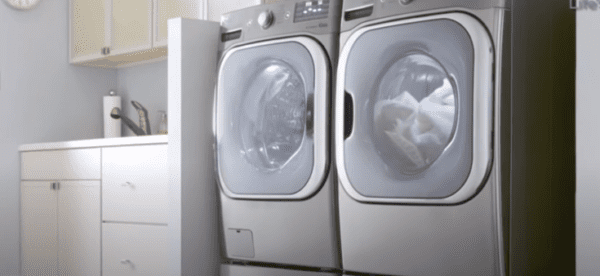Is your dryer leaving you with damp clothes even after running for three hours?
This can be a frustrating issue and a major inconvenience.
There could be several reasons behind this problem, from simple issues that you can troubleshoot yourself, to more complex ones that may require professional attention.
In this piece, we will delve into 15 common reasons why your dryer might be taking an excessive amount of time to dry your clothes.
The dryer Takes 3 Hours to Dry

1. Clogged Venting System
A clogged venting system is one of the most common reasons why your dryer might be taking longer than usual to dry clothes.
This happens when lint and other debris block the dryer’s exhaust vent over time, preventing hot air from exiting the machine.
Consequently, the damp air stays in the drum, and clothes remain wet for an extended period.
Fix
The solution to this issue is quite simple but requires thoroughness: regularly cleaning the venting system.
This includes detaching the vent from the back of the dryer and using a vent-cleaning brush to remove lint build-up from within the pipe.
It’s recommended to perform this task at least once a year or more depending on dryer usage. Remember, a clean venting system not only improves the efficiency of your dryer but also safeguards against potential fire hazards.
2. Overloaded Dryer
Overloading the dryer can result in extended drying times, as the heat won’t effectively circulate around the garments, leaving them damp even after a lengthy cycle.
This practice not only consumes excessive energy but can also prematurely wear out your machine.
Fix
The solution to this issue is to ensure you’re not filling your dryer past its capacity.
You should leave enough space for clothes to tumble freely, which aids the optimal circulation of heat.
As a rule of thumb, a dryer should only be filled to about three-quarters of its capacity for efficient functioning.
3. Malfunctioning Heating Element
A malfunctioning heating element is one of the common causes of a dryer taking longer than usual to dry clothes.
The heating element generates the necessary heat for the drying process.
If it’s not working properly, the dryer will continue to spin but without generating enough heat, resulting in damp clothes even after multiple drying cycles.
Fix
A solution is to replace the faulty heating element.
It’s recommended to use a professional appliance repair service for this task to ensure the appropriate safety measures are followed.
4. Broken Thermostat
The thermostat in a dryer is a critical component that regulates the temperature inside the drum.
If the thermostat is broken, it may not heat up at all or it may overheat.
In the case where it doesn’t heat up enough, this could cause your dryer to take longer periods, such as 3 hours, to dry your clothes.
Fix
The solution is to replace the broken thermostat. It’s a relatively inexpensive part and can be replaced by a professional or someone with adequate DIY skills.
Always remember to unplug the appliance before attempting any repairs to avoid electrical shock.
5. Faulty Timer
A faulty timer can result in your dryer taking excessively long to dry clothes.
This component regulates the duration of each drying cycle, and when malfunctioning, it can cause the dryer to run for longer than necessary.
Fix
A simple way to check if the timer is defective is by setting the dryer to a timed dry cycle and seeing if it shuts off when it should. If it continues to run, the timer is likely the culprit.
The solution to this issue typically involves replacing the timer. It’s a task that can be done by a skilled DIYer or a professional appliance repair service.
6. Inefficient Motor
An inefficient motor is a common cause of extended drying times in dryers.
As the motor ages or wears out, its efficiency decreases, making it harder to generate enough heat to dry clothes effectively.
This inefficiency results in longer running times and increased energy consumption.
Fix
The solution is to replace the motor, which will restore your dryer’s performance to its original efficiency.
It’s a straightforward task for any experienced appliance technician, and it can be more cost-effective than purchasing a new dryer altogether.
7. Worn Out Drive Belt
A worn-out drive belt is a common culprit behind a dryer taking longer than usual to dry clothes.
The drive belt is a critical component that ensures the dryer’s drum rotates uniformly.
Over time, due to regular use, the belt can wear down or even break, causing the drum to turn more slowly, which in turn increases the drying time.
Fix
Thankfully, a worn drive belt can be easily replaced.
You can do this yourself by purchasing a replacement belt and following the manufacturer’s instructions, or you can enlist the services of a professional repair technician to ensure the job is done correctly.
8. Blocked Lint Filter
A blocked lint filter in your dryer might seem insignificant, but it can lead to substantial inefficiencies, including prolonged drying times.
When the lint filter is clogged, the airflow within the dryer is significantly reduced.
This hampers the dryer’s ability to expel the damp, hot air, thus extending the time it takes to dry your clothes.
Fix
The solution is as simple as it is essential: Regularly clean the lint filter. After each cycle, remove the filter and clear off the lint.
This simple routine can significantly improve your dryer’s performance and reduce the drying time to normal.
9. Damaged Moisture Sensor
One common reason a dryer may take longer than usual to dry clothes is a damaged moisture sensor.
The moisture sensor in your dryer is an essential component that detects the dampness of clothes in the drum and signals the control board to stop the cycle when your clothes are dry.
If the moisture sensor is damaged or faulty, it may incorrectly signal that the clothes are still damp, causing the dryer to run longer than necessary.
Fix
To rectify this issue, the sensor should be tested for continuity and replaced if it is defective.
It’s recommended to seek professional assistance to ensure the replacement is done correctly.
10. Inadequate Power Supply
An inadequate power supply to your dryer can notably extend drying times.
Dryers are typically 220-volt appliances and need a sufficient power supply to function correctly.
If the voltage is too low, it may mean the dryer is not getting enough electricity to spin the drum and generate heat efficiently.
This is a common issue in homes with older wiring or in areas where the power load is high.
Fix
To fix this issue, you should have a professional technician evaluate your home’s power supply.
They may suggest upgrading your electrical panel or rewiring the outlet where the dryer is plugged in to ensure it receives the necessary power.
11. Problematic Cycling Thermostat
A faulty cycling thermostat can be a common culprit behind a dryer taking excessively long to dry clothes.
The cycling thermostat is responsible for regulating the temperature within the dryer – if it’s malfunctioning, it might not heat up the dryer sufficiently, resulting in damp clothes even after prolonged cycles.
Fix
To resolve this, it’s recommended to test the thermostat using a multimeter for continuity.
If readings show it’s defective, a replacement is necessary.
Remember, handling electrical components can be dangerous, so if you’re unsure, hiring a professional is always a better choice.
12. Faulty Thermal Fuse
A faulty thermal fuse could be the reason why your dryer takes an excessively long time to dry your clothes.
The thermal fuse is a safety device designed to protect the dryer from overheating.
When it malfunctions, it can disrupt the heat flow, causing your clothes to dry slower than usual.
Fix
Luckily, the solution is straightforward. You’ll need to locate and replace the thermal fuse, typically found on the heat duct.
It’s a relatively easy and cost-effective fix that can significantly improve your dryer’s efficiency.
Always remember to disconnect the dryer from its power source before attempting any repairs.
13. Restricted Air Flow
Restricted airflow is a common cause for a dryer’s decreased efficiency, leading it to take an excessively long time to dry clothes.
This can be due to lint build-up in the lint filter or venting system, blocking the free flow of air.
Consequently, the dryer’s ability to expel moist, hot air decreases, resulting in damp clothes even after a full cycle.
Fix
The solution is straightforward but crucial – regular and thorough cleaning of the lint filter and venting system.
Ensure your dryer’s vent pipe is not bent or kinked, as this too can restrict airflow.
By maintaining an unobstructed airflow, you can significantly improve your dryer’s efficiency and lifespan.
14. Malfunctioning Blower Wheel
A malfunctioning blower wheel could be a prime reason why your dryer takes longer than usual to dry your clothes.
The blower wheel works by driving air through the dryer drum and out via the exhaust vent.
Fix
If it is faulty or damaged, it can’t circulate air efficiently, leading to longer drying times.
For a solution, check the wheel for any signs of wear or damage.
If you find any, replacing the blower wheel should restore your dryer’s efficiency, reducing the drying time significantly.
15. Outdated Dryer Model
The inefficiency of an outdated dryer model can significantly extend drying times, sometimes up to three hours per load.
This is often due to the lack of advanced features found in modern machines, such as moisture sensors and improved heat distribution, which can significantly optimize the drying process.
Additionally, wear and tear over time can compromise the dryer’s performance.
Fix
To address this issue, one might think about upgrading to a newer model.
Modern dryers are designed to be more energy-efficient and faster, which would not only save time but also reduce electricity consumption, thereby offering a more sustainable and cost-effective solution.
Conclusion
A dryer taking three hours to dry is not an efficient or normal operation.
This issue may arise due to several reasons such as a clogged lint filter, obstructed ventilation, or mechanical defects.
Regular maintenance and timely repair are crucial to ensure the efficiency and longevity of your dryer.
Remember to frequently check and clean the lint filter, ensure the ventilation ductwork is not obstructed, and seek professional help if the problem persists.
This not only optimizes the dryer’s performance but also contributes to energy savings and fire safety.
FAQs
Is it normal for a dryer to take 4 hours?
No, it is not normal for a dryer to take 4 hours. A typical drying cycle should usually take about 30 to 60 minutes, depending on the load size and type.
How long does a dryer take to fully dry?
A dryer typically takes between 30 to 60 minutes to fully dry a regular-sized load, although this can vary depending on the type and volume of laundry.
How do you fix a slow dryer?
To fix a slow dryer, start by cleaning the lint filter and checking the vent pipe for any obstructions. If these measures don’t help, it may be time to call a professional.
Can clothes dry in 3 hours?
Yes, clothes can dry in 3 hours, especially in warm, dry environments or when using an efficient dryer. However, this can vary depending on the type of fabric and moisture levels.
Whirlpool Washer Not Agitating Properly
Beko Washing Machine Problems Reset
Dryer Taking Multiple Cycles to Dry
Whirlpool Washer Door Locked Flashing and Pump Running
Samsung Washing Machine vs Ifb
Why Is My New Whirlpool Washer So Loud
What Causes a Washing Machine Pump to Break
Whirlpool Washer Locked Light Flashing
Front Load Washer Filling With Water When Off
Why Is My Amana Washer Stuck on Wash Cycle
Speed Queen Wash Spin and Lid Lock Flashing 3 Times
Kenmore Washer Lid Lock Flashing


